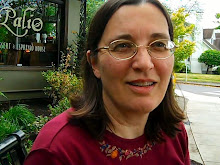To give a brief update, a while back, I had a chance to attend a Michael Hauge workshop in Portland. Michael is a Hollywood screenplay consultant whose clear and usable explanations of story structure make his workshop one of the best I've ever attended. And his application of story structure to the character arc -- the distinction between a character's identity and essence -- works for real people, as well as fictional characters. When I told my friend Barbara about it, she compared his approach to Thomas Merton's view of the true and and the false self. She half-jokingly suggested that we invite Michael Hauge to give a talk at our church. Michael would be -- surprised -- I think, at such an invitation, but since then, I've been noticing how that comes up in Church literature. That would be a long blog post in itself, and it's not what I wanted to talk about today.
A few weeks later, Larry Brooks, a student of Michael's who writes thrillers and lives here in Oregon, gave a coaching workshop. Nine writers sat around a table and spun our stories for each other. We didn't read text; instead, we gave the plot overview and talked about how to strengthen our stories and our characters. We asked each other the annoying questions: "But why does it have to be that way?" and "What if you did it this way?" It was enormously productive, and hearing all these stories, even in embryonic form, was like belonging to a storytellers' club. (By the way, if there's a critique group in the Portland area that's open to doing story structure this way and that has an opening . . . .) And having my own story dissected, having someone not emotionally attached to the thing look at the structure, opened my eyes to new ways of solving problems that have plagued it since the beginning.
So I've been going through my story and inserting a plot. The most important thing -- the thing worth doing the story for -- is the theme, but Larry said that if the theme is important, you put it aside and tell your story and trust it to carry the theme when all is said and done. Otherwise, you risk driving the story to tell what you want to tell. My problem was that the action wasn't strong enough to keep the reader interested. And since I'm plotting first and writing later, I can experiment with different things without investing so much time in the writing and rewriting and so forth.
So I'm looking at making the story something that you could tell to a group of people around a campfire and have them all hanging on every word. I'm also looking for good scenes -- as for example Neil Gaiman's Neverwhere. In other words, fun scenes, exciting story, compelling characters, profound theme. Sound like a tall order? I think so, too.
So where was I? Compossible. Right.
Anyway, I heard Linda Seger interviewed on the podcast The Writing Show. Seger suggested that when your character needs to do something important in the story, brainstorm a list of 30 or more possibilities. The first two or three will be predictable, she said. After that, you get into more surprising possibilities. The list of 30 ways Protagonist might escape from prison will then include such things as being beamed up by aliens, having the prison decide he's not really guilty, blowing things up, stealing guards' uniforms and so forth. I sort the final list into "Heh" (beamed up by aliens); "Nah" (setting him loose); "Maybe" (blowing things up, stealing uniforms); and "Yeah" (there may not be any). But the what's been happening is that the list contains two or three compossible "Maybe"s that add up to a big ding-ding-ding-ding! "Yeah."
Powered by ScribeFire.
